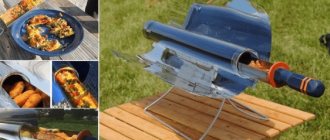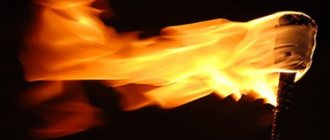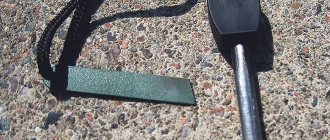Many tourists, hunters and fishermen, in order to boil water at a rest stop, had to decide how to light a fire in windy weather. More than once or twice they thought about how to make it so that they did not have to constantly adapt to the changing wind, placing firewood on the right side, or moving a stick with a pot hanging on it. And the way out of this situation is not difficult. It is enough to light a “Finnish candle”.
This memorable name hides a whole group of wood structures that allow you to warm up and cook food in camp conditions with sufficient comfort. The ability to make a Finnish candle, both among tourists and among hunters, fishermen and simply lovers of outdoor recreation, is not common. Let's try to fix this. So, let's start.
Today there are many names for this method of making a fire:
- Finnish candle;
- Swedish candle;
- Indian candle;
- hunting candle;
- wooden primus stove.
Underneath them are hidden fires that are fundamentally similar in design, built inside a specially prepared chock or between several combined chocks standing vertically.
Application area
Such options are suitable for both cooking and heating.
Moreover, a full-fledged fire can be lit even with a lack of fuel, sometimes making do with just one log.
This long-lasting fire withstands windy weather well, it is quite compact, economical, does not require the installation of additional devices for cooking and can withstand precipitation quite well. Since even heavy rain, with the pot on the fire, will not be able to extinguish it.
During its use, many changes were made to the design, depending on the conditions of use. The classic “Finnish Candle” fire originally consisted of a log split into two halves, which were then fastened together in places where they were chipped using wire, rope or other available materials. Over time, for better combustion, the chock was no longer split into two halves, but into more parts. Then, instead of splitting, they began to make cuts and even assemble a fire from several logs pressed vertically against each other.
Purpose of the fire
The unique design of the Finnish candle allows you to build a real fire using a minimum amount of fuel, sometimes one log is enough for this. In addition, such a fireplace is not afraid of precipitation (if the combustion center is covered) or strong wind.
Fields of application while hiking:
- Lighting. A smoldering fire will light up the place where you spend the night and will not go out in case of sudden rain or gust of wind.
- Heating. In cold weather, it quickly heats up and guarantees constant safe warmth and comfort.
- Orientation. When going on a distant walk, you can easily determine your location using a taiga fire and easily find your way back.
Interesting fact. A log fire, in contrast to the classic one, leaves almost no traces, and therefore does not harm the environment.
For culinary purposes
In a natural environment, using a Swedish candle it is possible to:
- cook hot food in a cauldron;
- to boil water;
- reheat prepared food;
- process the game carcass.
It is worth noting that such a “log stove” is equally functional under any circumstances, including in windy areas. Moreover, it is not necessary to know how to make a tripod for a fire, since the pot can be placed directly on the log.
How to make a Finnish candle
First of all, you need to decide on the design. This depends on several factors:
- the presence of thick logs and good tools at the resting place;
- the presence of wire for tying thin logs and split logs;
- soil composition;
- number of people in the group;
- the need to dry things.
Almost all options are divided into two groups according to manufacturing method:
- from one fairly thick piece of wood;
- from several logs with a smaller diameter.
Now let's proceed directly to manufacturing.
Which log to choose
You should approach the selection of a suitable log quite seriously and responsibly. The choice depends on what exactly you want to get. Are you interested in camp lighting? Then a not too thick log with a diameter of about 10-15 centimeters will do. Of course, it will burn out relatively quickly, but it will cope with the function perfectly.
Do you need to cook dinner, which means putting a pot on top of the fire? In such a situation, the best choice would be a thicker log with a diameter of at least 20-25 centimeters. Make sure it's stable enough that it won't fall over at the slightest touch, knocking over the pot of almost-finished dinner and leaving you without supplies.
Almost any wood will do. Birch burns well and ignites easily. Oak produces particularly powerful heat, but cutting it can be quite difficult. The only thing you should refrain from is using coniferous species. Because of them, the pot will become particularly smoky - cleaning it will be quite problematic. However, for lack of anything better, pine and spruce will do.
Solid block with cuts
To do this, take a piece of wood with a diameter of 20 cm. We make cuts in it so that we get several lobes. Usually their number ranges from two to eight. Then, in the center of the log, using wood chips and available materials, a fire is lit. To do this, you can lightly chop off the central parts of the lobes.
Gradually the fire spreads down the cuts. The fewer cuts, the longer the combustion, the more of them, the hotter the fire. The cuts are made to a depth of up to 3/4 of the height. Oxygen penetrates through the cuts to the combustion site. Over time, this version of the Finnish candle burns out the upper middle part, and the open fire turns into smoldering. After this, cooking will be quite difficult, but for heating it will be quite suitable.
We split the log
Any tourist has a hatchet with him, and sometimes also a folding saw or chain saw. Very handy - both tools will be useful for the job.
First of all, cut or cut a long enough log. Now split it into several pieces - most often from 4 to 6. The core is usually also chopped and crushed to make a small hole. The resulting parts are put back together in the same order, often fastened with wire - then they will definitely not fall apart under the weight of the pot. There is no need to fit them too tightly - otherwise air will not flow to the fire in sufficient quantities, the draft will worsen and the fire will barely smolder. All that remains is to put the crushed core into the resulting hole in the center, add paper or birch bark there for kindling and throw a match. After a few minutes, the candle will flare up - you can use it for its intended purpose.
Split Wood
This option is very similar to the first. In it, all parts of the initially chopped lump are tightly connected with wire to each other. First, the central parts of the lobes are slightly planed. This will provide enough wood chips for ignition and create channels for air draft. After this, the parts of the chock are tightly tied together with wire, starting from the middle.
You need to tighten the bottom especially carefully, otherwise your fire will fall apart as it burns out. You can also use rope instead of wire, but this option is less reliable. Please note one nuance: unlike sawn wood, the chips are pressed very tightly. There is practically no fire coming through the sides, so this option cannot be used as a heater. But it burns longer without disintegrating, it can be moved quite easily from place to place if necessary, and it has a fairly strongly directed flame.
“Taiga” fire
A long-lasting fire used to heat a camp. This fire produces a lot of heat and is made quite simply, of course, if you have firewood (logs) of the required diameter. You can sleep by a properly made taiga fire even in winter. Such a fire can be made in the snow; the fire is very stable in weather conditions. Three relatively thin logs 2-3 meters long lie on one thick log (zavalok, subjurlok). The logs are pushed forward a little, brought together at the top (the ends are separated) and set on fire from below. When filling, 3 logs should lie on the leeward side. This is done so that the part of the logs that is not pushed beyond the fill does not catch fire. As the logs burn through, they will need to be moved. As a rule, it is enough to get up 1-2 times a night.
Chock with two holes
As the name suggests, a couple of holes are made in a vertically standing block. One from top to bottom, to the same length as the cuts in the first option, at 3/4 of the height. The other is at a right angle to the first at a height of 1/4 from the bottom of the block, so that the holes are connected.
You can ignite both through the top hole and through the bottom. This method is the most effective for cooking, but also the most difficult to manufacture due to the need to use additional tools.
Other names
This type of fire is very popular among lovers of an active lifestyle. And it has a lot of names. This creates real confusion - it is not always possible to immediately understand what the interlocutor means.
Therefore, we present the most common names to solve the problem of terminology.
Most often, this fire is associated with a candle (due to its external similarity), and it is called both Finnish or taiga, and Indian, hunting, Swedish, Scandinavian, Canadian and even Roman. In addition, you can sometimes hear the names vertical fire, volya, wood-burning or wooden primus stove. So, having heard any of these names, you will know exactly which fire your interlocutor is referring to.
Assembly of thin logs
This option is suitable if you don’t have a tool. In this case, three to five logs are placed on their ends and tied in a vertical position.
Such a stove is easier to manufacture and ignites much easier, which is important if you have insufficient experience.
The first three options require a log with a diameter of 20 to 30 centimeters. Large diameters are not advisable. The height should be approximately twice the diameter. With this ratio of diameter and height, your hearth will be the most stable.
Bonfire "Even" ("Yurlok")
The Even fire is made like a taiga fire. But parallel logs laid on the base create a canopy-reflector, under which the main fire is lit. The idea is that the logs should not so much burn as direct the heat forward, preventing it from going up uselessly. The original source recommends laying the logs in a fan, arguing that in this case the fire will not go back.
But some people prefer to lay the logs in parallel. Approximately like this
The Evenki fire is one-sided. It only burns on one side of the base. All the heat goes to this side. On the other side of the main log it remains cold. Under no circumstances should the bottom log be allowed to burn out, so you can use damp wood or even stone.
Useful tips
Now let’s take a closer look at perhaps the most important issue. How to light a fire, which is described above. Even for experienced tourists, this problem will arise during their first attempts. How can you make a Finnish candle burn faster? Yes, very simple. It is enough to remember the elementary laws of nature:
- the flame burns only if there is a sufficient supply of oxygen;
- heated air always tends upward.
Therefore, for successful combustion it is necessary to ensure that these two conditions are met. Namely, there must be at least a small gap between the parts of the chopped wood so that the flame moves freely upward, and there must be a free flow of air from below. This can be achieved in the following ways:
- slightly cut off the central parts of the chopped logs with a knife or an ax;
- using available means (for example, stones or a pair of thin sticks) raise the fire above the ground;
- chop off the lower parts of at least two adjacent parts so that a small channel for air flow is formed into the center of the fire.
The second option is not very successful, since a fire lit in this way will not be stable enough.
Security measures
Like any other sources of fire, a Finnish candle requires accuracy, vigilance, and compliance with the following safety rules:
- The fire pit should be located away from dry trees. And it is better to thoroughly clear the clearing itself of grass, leaves, and pine cones in order to prevent the possible spread of fire.
- Despite the fact that this design is relatively safe, it (if possible) should not be lit on peat bogs.
- Containers with lighter fluid must be kept at a safe distance from the fireplace.
When constructing a Finnish candle, it is imperative to follow safety precautions, use protective gloves and goggles.
Making a Finnish candle on your own is not that difficult. To do this, you need to familiarize yourself with the features of such a mini-bonfire, strictly follow the construction technology in practice, and listen to useful recommendations. Then a long rest in nature will be comfortable: with hot food, constant warmth, dry clothes even in case of bad weather.
Cooking
Finally, let's move on to the most “delicious” part. How to cook on a Finnish candle? It turns out that it’s also nothing complicated. Any cookware that can withstand cooking over a fire will do.
But we must not forget that the fire must be provided with a way out. If you place a saucepan or kettle directly on the chock, the fire will stop burning normally and the water will not boil. This issue can be resolved as follows:
- place a stand on top of the log in the form of two freshly cut sticks up to 5 cm thick;
- When assembling, two or three parts of your candle should be higher than the rest by the same distance.
In the second case, this can be achieved in different ways. If we assemble a candle from several thin logs, then in advance, when cutting, two of them are made longer than the others. When placed vertically, they will provide the necessary gap between the dishes and the surface. Or, when assembling, you can move two logs slightly upward compared to the rest. You can do the same in the case of chopped logs. This method allows you to simultaneously provide two channels for air supply from below. And the fire will burn more steadily and hotter.
Happy travels!
Advantages and disadvantages of a fire
Any type of fire, incl. Finnish candle has strengths and weaknesses. As practice shows, various options for such a small fire have the following advantages:
- Economy, burning time. To create such a design, at least one log is required.
- Safety. It is allowed to use even on peat bogs.
- Compactness. Logs can be stored under an awning and transported in a car without any problems.
- Mobility. Can be carried even during the burning period.
- Ease of erection and ignition. Even a beginner can handle installing a fire pit.
- Can serve as a stand for dishes. The logs have straight cuts.
- Environmental friendliness. They do not leave traces on the surface of the earth and do not harm nature.
- Resistance to adverse weather conditions. Such fires do not go out due to wind or rain (when the burning center is covered with dishes).
- Possibility of renewal. If the log is stored in a dry place, it can be quickly rekindled.
Ignition blank
Main disadvantages:
- Construction requires an ax and a saw. Tourists and vacationers do not always have such tools.
- The wood must be of a certain type and the required thickness. It is difficult to find such preparations in the steppe or field.
- Weak degree of heating, only at a short distance.
- You can only cook one dish. The second pot no longer fits on the work surface. In matters such as lighting a barbecue, it is better to choose another fire option.
Interesting fact. The true inventors of the Finnish candle were the ancient Indian tribes (North American). They used this type of fire during nomadism, because... they were constantly pursued by the British.
How the head of the NOD is connected with million-dollar grants
At the request of Bumaga, the funding of the NOD was analyzed by the international anti-corruption organization Transparency International.
Experts noted that Russian pro-government movements, which claim a lack of centralized funding, often receive funds through a developed network of non-public non-profit organizations and grants. An example, according to the organization, is the “Network” project or “Officers of Russia”. This financing scheme allows them to hide the real volumes of funds received and spent.
Among the organizations with which NOD leader Evgeny Fedorov is associated, there are also a number of recipients of presidential grants. For example, the Institute of Economics and Legislation, which is often mentioned on Fedorov’s official website, has received grant support three times. In 2014 - 6.5 million rubles for the “development and adaptation of a network management model in government bodies in order to improve the dialogue between society and government”, in 2015 - more than 6 million for the project “New type of wars: current challenges to ensuring national security of Russia and countering non-military technologies for desovereignization of the state” and 4 million in 2016 for the project “Methodology and methodology for forming a system of patriotic education of citizens: world and Russian experience.”
A place for a node and a bivouac with it
Both in the spring-autumn and in the winter, sufficient attention must be paid to preparing the site for the node. It may seem that making a node is simple, but this is to some extent a myth. In reality, for the purposes for which it is used, the node must be combined with a very well-constructed shelter that will accumulate heat, protect from precipitation and wind, and will not catch fire on its own. It is difficult to make such a shelter, and therefore a full night’s stay in the taiga with a node requires a long preparation of the camp.
The entire structure of the bivouac must provide not only warmth for people, but also safety - the fire should not be extinguished by snow, the canopy and supports should not fall into it.
In winter, the place for the node must be cleared of snow, since a fire that burns for a long time can melt the snow and go deep into the snowdrift, ceasing to warm the person lying next to it.
In deep snow, a good option is a deck of two two-meter poles laid under the fire perpendicular to it. Due to the area of contact with the snow and the distance from the combustion source, the poles will remain on the surface of the snow cover and will not allow the fire to “drown” in the snow.
To prevent the log from rolling on the poles, a transverse indentation is made on one side with an ax. With this recess, the log is placed on one pole, and a part of the log without the recess is placed on the second.
With the proper organization of a bed and a bed, a person can spend the night in the forest even in very severe frosts. A well-prepared node does not require attention for a long time and provides enough heat throughout the night to warm the person lying opposite it at -20°C - -30°C and prevent him from freezing.
The photo below shows a bivouac with a node, in which a person can spend the night at almost any air temperature without risking his life:
If a person sleeps alone, the bed is located parallel to the nodier; if two people are planning to spend the night, then both beds are located parallel to the fire on opposite sides of it. Only when positioned parallel to the fire will the body be sufficiently warmed by the heat of the fire.
When one person is resting on the side opposite the fire, you can make a screen that reflects heat. To do this, two pairs of stakes are driven into the ground, between which thin logs are laid one on top of the other, forming a kind of fence equal in width to the length of the fire. The top of such a screen can be insulated with spruce branches. However, in practice, many do without such a screen.
The fire and the bench are installed at a slight angle to the direction of the wind. With this arrangement, the fire is fanned by air currents, and the smoke does not fly towards the resting person.
It is recommended to make the bed on logs, laid in several floors and covered with heat-insulating material, for example, a carpet mat. In this case, the person sits opposite the fire and receives maximum heat from it. In addition, moving away from the cold ground reduces heat loss. Also, such a bed protects a sleeping person from a log rolling towards him. Although, of course, other simpler options for beds are also possible.
A canopy made of synthetic fabric can be replaced with a barrier made of poles and spruce branches, but making it is quite labor-intensive.
A canopy is installed over the bench, which protects the vacationer from precipitation and serves as a kind of screen that reflects the infrared radiation of the fire and thus increases its efficiency. If there is a chance of precipitation, you should also make a canopy over the fire.
Vertical installation
Have you ever wondered why a node burns for a long time? And it burns for a long time because this fire has a small area of interaction between the logs and almost completely lacks its own draft.
Thus, if prepared logs are placed vertically on a small fire, a draft will form between the logs, and they will burn much more cheerfully.
True, in the process of such preparation and breeding of Nodi, you need to carefully monitor safety precautions.
Vertically lit logs, after being laid in a traditional position, smolder, almost like a log lit in the usual way.
How much did I spend per month in GCD
Valery agrees with him. A short, strong builder of about 55 regularly goes to protests, despite health problems and many months of sick leave at work. He has been in the NOD for more than a year, and before that he was a member of another patriotic movement with a conspiracy theory - the Great Fatherland Party (GVO) of Nikolai Starikov. He believes that one of the main reasons for the gradual transition of the NOD is that participation in the movement requires virtually no monetary expenditure.
— I spent almost 50 thousand in air defense over the entire time, can you imagine? “But here there are no contributions, nothing,” he complained when we stood together on Nevsky with posters in praise of Putin.
Indeed, in a month I spent only 500 rubles in the NOD: I donated it as a gift for March 8th to one of the activists. At the same time, I was given a flag and a one-kilogram set of propaganda materials—leaflets and newspapers—completely free of charge.
However, problems with financing still have an impact. Most of the propaganda campaigns are printed by seasoned activists at their own expense, and therefore they have been going to protests for years with the same worn posters and handing out old newspapers. In March 2022, we stood at promotions with materials for 2016.
— Our principle is the absence of centralized financing. GCD is a movement from the bottom up,” explained Evgeny Fedorov. At the same time, the deputy himself may have such funding.
Kindling materials
In addition to firewood, a fire also requires kindling material. In the taiga, such material is most often dry bark, small cones of spruce or pine, dry moss or lichen. In a birch grove you can use birch bark. This is the perfect kindling.
View gallery
In taiga areas that border the sea, dry Chosenia (swamp willow) bark is used. If you need kindling in damp, humid weather, you can make it by splitting a dry trunk and collecting thin splinters from the inside of the tree. You can also use pine litter, which accumulates under the roots of a tree; such material ignites well. It must be remembered that if you plan a stick in such a way that thin burrs remain on it, it will flare up much faster. And, of course, the presence of such simple and light substances as dry alcohol, or for example pieces of plastic will greatly simplify the ignition process, giving a hot flame.
Biography
Nodier came from the provincial petty bourgeoisie; his father was the chairman of the revolutionary tribunal in Besançon during the French Revolution. At the age of twelve, Charles joined the Besançon Society of Friends of the Constitution, a club close to the Jacobins. In 1797 he created a new circle of “Philadelphians.” The revolutionary sentiments of his youth were later replaced by Nodier's play at being a revolutionary. In 1802, he composed a poetic pamphlet against Napoleon, but later became his supporter and received a position in the administration; nevertheless, during the Restoration he presented himself as a victim of the Empire.
Nodier was professionally engaged in entomology, was the author of “Discourse on the purpose of the antennae of insects and their organ of hearing” (1798; co-authored with F. M. J. Luxot) and “Entomological Bibliography” (1801), which even Lamarck approved. His interest in entomology remained throughout his life; he repeatedly addressed the topic of insects in his articles and works of art.
While serving as a librarian in the capital of the Illyrian provinces of Laibach, he wrote the robber novel “Jean Sbogar,” which, after publication in 1818, brought the author European fame. In his works he was a conductor of foreign literary romantic influences on French literature. He developed the genre of a fantastic short story, which was divided into a “nightmare” short story (“Lord Rutween, or Vampires” (French Lord Rutween, ou Les vampires, 1820), “Smarra” (French Smarra, 1821), a fairy tale (“Trilby "(French Trilby, 1822), "The Fairy of Bread Crumbs" (French La Fée aux miettes, 1832) and a religious legend ("The Legend of Sister Beatrice" (French La légende de sœur Béatrix).
On January 3, 1824, Nodier was appointed librarian to the Comte d'Artois, the future King of France Charles X, and participated in his coronation in Reims. From April 14, 1825, he served in , officially taking up the post of librarian on May 29, together with Victor Hugo. This work gave Nodier access to rare and forgotten books, which he tirelessly promoted. His apartment, along with Hugo’s, became the meeting place of the first association of French romantics - the Cenacle, which was dominated by representatives of the noble literature of the 1820s. This association, which collapsed by the early 1830s, played a significant role in the new school’s struggle against classicism. The printed organ of Cenacle was the Catholic and monarchist magazine “The French Muse” (French: La muse française).
In 1835, Nodier published a bibliography of French literary madmen - a work that was continued in the 20th century by Raymond Queneau and
The author of a multi-volume work on the cities of France “Voyges pittoresques”, in which he paid much attention to the Templars. Anonymously published the resonant “History of Secret Societies” (1815).
Nodier's work is full of contradictions. Along with mysticism, the product of which are fantastic stories, he coexists with the materialistic tendencies of the 18th century, along with reactionary statements - some social ideas of the Great French Revolution (“Jean Sbogar”). In contrast to his lyricism and wild imagination, he uses the clear, precise, dry language of the 17th century. Having adopted a number of romantic features, he retains the influence of Crebillon the son and Laurence Sterne.
He was buried in the Père Lachaise cemetery.











